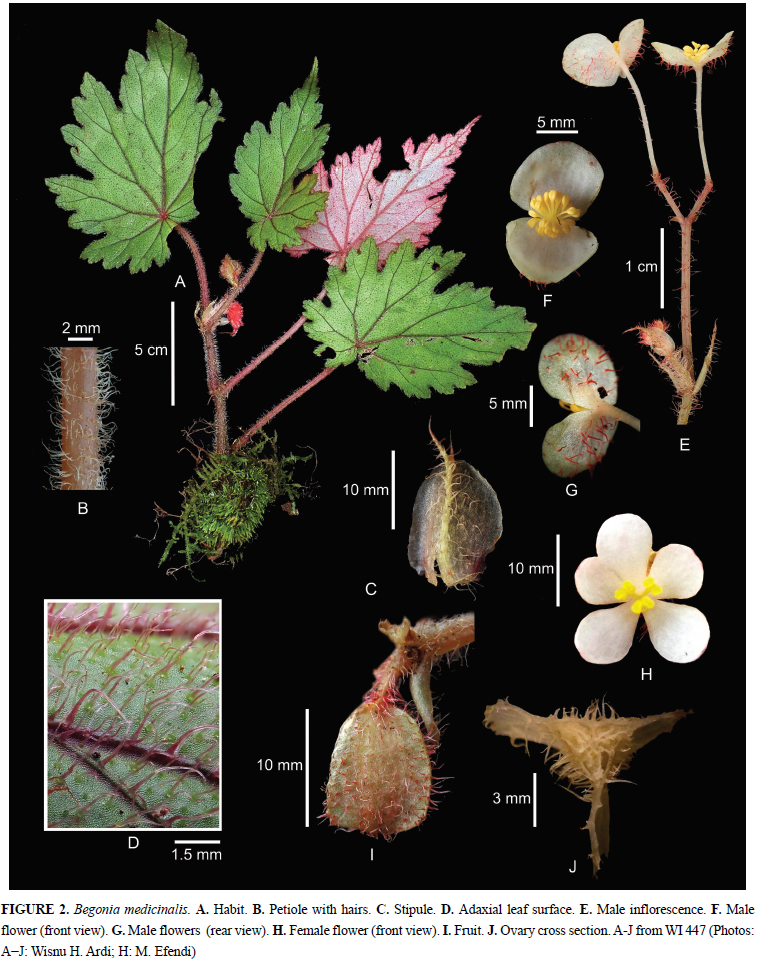Begonia medicinalis in Phytotaxa 423(1): 42. 2019
Primary tabs

Diagnosis
- This species resembles Begonia lasioura D.C.Thomas & Ardi (Thomas et al. 2011: 233) in the erect habit, the dense indumentum of relatively long (to ca. 2 mm) hairs of the stems and leaves, and the short peduncles of the female inflorescences, but differs by its lower growth habit up to 30 cm tall (vs up to 60 cm tall); a biserrate to shallowly lobed leaf margin (vs leaf margin serrate); and obovate female flower tepals (vs tepals ovate to elliptic). (Ardi, W.H., Zubair, M.S., Ramadanil, Thomas, D.C. (2019). Begonia medicinalis (Begoniaceae), a new species from Sulawesi, Indonesia in Phytotaxa 423(1): 41-45.. http://doi.org/10.11646/phytotaxa.423.1.5)
Description
- Perennial, monoecious herb, erect, up to 30 cm tall, with a dense indumentum of multicelullar, simple trichomes up to 2 mm long and microscopic glandular hairs on stems and leaves. Stem few-branched, internodes 2–5 cm long, brownish. Leaves alternate. Stipules caducous, pale green, elliptic, 15–20 × 7–13 mm, midrib slightly prominent, apex narrowed into bristle up to 5 mm long. Petiole concolorous with the stem, 3–9 cm long. Lamina basifixed, asymmetric, ovate to elliptic, 9.5–15 × 4–8 cm, densely covered with crimson or reddish hairs on both surfaces, adaxially green with reddish veins, abaxially paler, base shallowly cordate, lobes not overlapping, apex acuminate, margin biserrate to shallowly lobed (up to ca. 25% of the lamina width). Primary veins 4–6, actinodromous, secondary veins craspedodromous. Inflorescences protogynous. Female inflorescence one node basal to male, two-flowered or female flowers solitary, peduncle 1–5 mm long, hairy. Male inflorescence cymose-paniculate, comprised of 2–6 monochasial partial inflorescences, each with 3(–5) flowers, peduncle 0.8–2 cm long, hairy. Bracts persistent, 1–2 × 1.5–2.5 mm, broadly ovate, abaxially hairy. Male flowers: pedicel 11–12 mm long, hairy. Tepals 2, white tinged pink, 7–9.5 × 6.5–10 mm, broadly ovate, adaxially with moderately dense indumentum of multicelullar, red hairs. Androecium of 29–36 stamens, yellow, filaments ca. 0.5 mm long, slightly fused at the very base, anthers ca. 1 mm long, obovate, apex obtuse, dehiscing through unilateraly positioned slits ca. ½ as long as the anthers. Female flowers: pedicel 1–2 mm long, green, hairy. Tepals 5, subequal, 9−12 × 6−8 mm, obovate, margin glabrous or sparsely ciliate, apex rounded, abaxially hairy. Ovary (excluding wings) 9–15 × 2–6 mm, green, hairy, locules 3, placentation axile, placentae bilamellate, wings 3, equal, base rounded, apex subtruncate, style basally fused, 3-branched, each stylodium bifurcate in the stigmatic region, stigmatic surface a spirally twisted papillose band, orange. Fruit: peduncle 1–5 mm long. Pedicel 1–2 mm long. Seed-bearing part ellipsoid or cylindrical, 10–15 × 2.5–6 mm (excluding wings), hairy, dehiscent, splitting along the wing attachment, wing shape as for ovary, up to 6 mm at the widest point (apically to subapically). Seeds unknown. (Ardi, W.H., Zubair, M.S., Ramadanil, Thomas, D.C. (2019). Begonia medicinalis (Begoniaceae), a new species from Sulawesi, Indonesia in Phytotaxa 423(1): 41-45.. http://doi.org/10.11646/phytotaxa.423.1.5)
Habitat
- Primary tropical rain forest, growing in shady and humid places on or between larger rocks, at ca. 700 m elevation. (Ardi, W.H., Zubair, M.S., Ramadanil, Thomas, D.C. (2019). Begonia medicinalis (Begoniaceae), a new species from Sulawesi, Indonesia in Phytotaxa 423(1): 41-45.. http://doi.org/10.11646/phytotaxa.423.1.5)
Conservation
- Data Deficient (DD). This species is only known from two localities (Morowali and East Luwu Regencies), and the forests in the wider area are botanically very poorly explored. Consequently, we assess this species as Data Deficient (IUCN 2012). (Ardi, W.H., Zubair, M.S., Ramadanil, Thomas, D.C. (2019). Begonia medicinalis (Begoniaceae), a new species from Sulawesi, Indonesia in Phytotaxa 423(1): 41-45.. http://doi.org/10.11646/phytotaxa.423.1.5)
Distribution (General)
- Endemic to Indonesia, Sulawesi (Morowali Regency, C. Sulawesi; East Luwu Regency, S. Sulawesi). (Ardi, W.H., Zubair, M.S., Ramadanil, Thomas, D.C. (2019). Begonia medicinalis (Begoniaceae), a new species from Sulawesi, Indonesia in Phytotaxa 423(1): 41-45.. http://doi.org/10.11646/phytotaxa.423.1.5)A
Etymology
- The specific epithet ‘medicinalis’ refers to the use of this species in traditional medicine in Central Sulawesi (see Introduction; Anam et al. 2014). (Ardi, W.H., Zubair, M.S., Ramadanil, Thomas, D.C. (2019). Begonia medicinalis (Begoniaceae), a new species from Sulawesi, Indonesia in Phytotaxa 423(1): 41-45.. http://doi.org/10.11646/phytotaxa.423.1.5)B
Notes
- Begonia medicinalis differs from B. lasioura as discussed in the diagnosis. There are a few other species with a similarly dense indumentum of relatively long hairs on the vegetative parts such as B. chiasmogyna M.Hughes (2006: 193), B. gambutensis Ardi & D.C.Thomas (Ardi et al. 2014: 260) and B. prionota D.C.Thomas & Ardi (Thomas et al. 2011: 237), but B. medicinalis can be easily distinguished from these species by several characters (see Table 1). (Ardi, W.H., Zubair, M.S., Ramadanil, Thomas, D.C. (2019). Begonia medicinalis (Begoniaceae), a new species from Sulawesi, Indonesia in Phytotaxa 423(1): 41-45.. http://doi.org/10.11646/phytotaxa.423.1.5)

